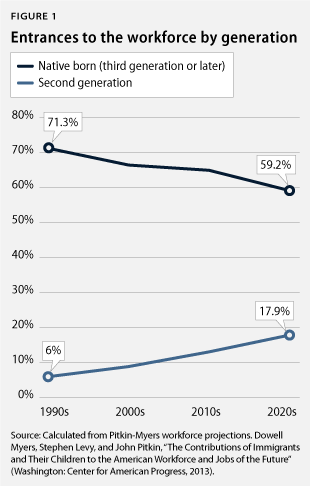Josef and Peachie[1]
Josef is a second-generation immigrant. His Filipino parents came to the United States more than 30 years ago and landed in San Jose, California. In the Philippines, his father was a teacher at a high school on the island of Palawan, and his mother was a nurse at the local hospital. Now, in the United States, his mother works at a nail salon, and his father is a taxi driver. While his parents have lower earning potential in the American workforce, their sacrifices year after year were for their children’s futures. Josef’s younger sister Peachie is a sophomore at UCLA, where she is majoring in chemical engineering, and she hopes to pursue a master’s degree following graduation. Josef just received a bachelor’s degree in chemical engineering and is starting his first year of medical school, following in his mother’s footsteps.
Over the next 20 years, the U.S. workforce will become younger, more diverse, and undeniably American—much like Josef and Peachie. Second-generation immigrants are an integral part of the American labor force. As the Baby Boom generation retires from the workforce—in the largest exodus of people from the workforce in American history—the children of immigrants will be key to our nation’s long-term economic growth and future sustainability. Whether it’s in a kindergarten classroom, a hospital, or a university science lab, the contributions of the 20 million U.S.-born children of immigrants will be critical to our nation’s future.

Immigrants, and particularly their children, will play a critical role in filling the workforce gaps created by the massive Baby Boomer retirements over the next two decades. According to a recent Center for American Progress report, by 2030 nearly 31.5 million, or 38 percent, of the 83 million new workforce entrants will be immigrants and their children. The second generation will account for a majority of workforce growth, as projections show that 12.9 million children of immigrants will enter the workforce by 2030. The report estimates that the share of second-generation immigrants in the workforce will triple, from 6 percent in the 1990s to 17.9 percent by 2030. At the same time, the share of native-born people entering the workforce will continue to drop—from 71.3 percent in the 1990s to 59.2 percent by 2030, as the number of new native-born entrants will not be able to keep pace with the large number of exits.
Research also shows that the children of immigrants make significant social and economic gains that prime them for a more prominent role in the workforce. On average, second-generation immigrants, regardless of their ethno-racial group, outperform their parents in educational attainment, occupational status, and wealth, demonstrating their progress and integration into society. As these projections indicate, the children of immigrants will be an integral part of our future labor force that can secure America’s long-term economic growth.
Conclusion
An immigration system that focuses on our workforce needs and embraces aspiring citizens will help ensure that the second generation—a major part of our future workforce—can maximize its potential. Research shows that the children of immigrants with legal status have better outcomes in educational and economic progress than those whose parents remain undocumented. Passing immigration reform will provide the 4.5 million U.S.-born children of undocumented parents an opportunity to integrate into American society and work legally, to earn the higher wages that come with legal status, and to have access to higher levels of education that are significant determinants of mobility. A system that provides the children of immigrants the opportunity to achieve their economic potential will benefit the overall economy.
In addition to immigration reform, our nation must make policy investments that facilitate the mobility of all future workers. Investments in educational attainment and workforce development that enhance future generations’ productivity and economic potential will lead the entire nation on a path to sustained growth. As our succeeding generations enter the workforce, it is imperative that we invest in policies that develop their human-capital potential and better prepare the country for future economic growth.
Angeline Vuong is a Project Manager for the Immigration and Progress 2050 teams at the Center for American Progress. Zach Murray is a former Congressional Hunger Fellow at the Center. Abhay Aneja is a former Legal Fellow at the Center.
[1] This is an actual story from personal communication with friends of one of the authors.